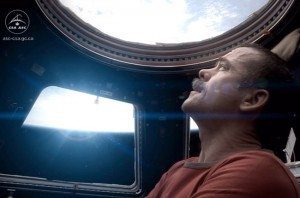Chris Hadfield touched down early this morning after spending 146 days in space as Canada’s first commander of the International Space Station (ISS).
Apart from carrying out his mission, Hadfield explained what happened when you cry in space, how astronauts clip their nails and brush their teeth, and what happens to vision quality in space.
Many may know him better for an almost true-to-life performance of David Bowie’s “Space Oddity” which he performed on board the ISS with a guitar:
He has also gained a unique perspective on the way that humans are changing the climate of our planet from an orbital perch.
Florida Today reported earlier this year that Hadfield told Canadian reporters (translated from French) that we are changing the planet and are responsible for what happens to future generations:
Climate is changing naturally, and perhaps as a result of what we have done, our influence…. And so maybe we just need to be more responsible in the decisions we make and think of the longer term, more than five years, more than the upcoming elections, more than just one lifespan, and think about our grandchildren and even further.
He also commented on how different the Aral Sea looked from orbit nearly 20 years after his first visit to space. The sea has dried up for a number of reasons (mainly diverting rivers for irrigation), which as Hadfield said, “was human change — change that has occurred thanks to what humans have done.”
While astronauts are not climate scientists, it must be a very surreal to look back down on the planet from the station and understand what Homo sapiens sapiens has done to the planet.
The mission of the International Space Station is multifaceted, but some of the instruments on board collect important climate data according to NASA:
Several instruments relevant to Earth science and climate change are either in development or already deployed on the station. The zenith port of the CEPF is currently occupied by the ESA Sun Monitoring on the External Payload Facility of Columbus, or SOLAR, instrument, which measures the sun’s energy irradiance — an important parameter for climate studies.
The ESA Atmosphere Space Interactions Monitor, orASIM, which will study high-energy optical and gamma ray events associated with thunderstorms, will be deployed on Columbus in 2015.
On the external platform of the Japanese Kibo module, the JAXA Superconducting Submillimeter-Wave Limb Sounder, or SMILES instrument, measured trace gases in the stratosphere, including chemicals that interact with the Earth’s ozone layer.
Also mounted on the outside of the Kibo, the NASA Hyperspectral Imager for the Coastal Ocean (HICO) is an imaging spectrometer for studying coastal waters.
More climate science research could be headed to the ISS. A call for research ideas in 2011 from the European Space Agency revealed significant global interest in attaching remote-sensing instruments for climate and global change studies to the station. Following a peer-review process, candidate experiments will be developed for use.
What is next for Commander Hadfield? Perhaps he could explore the ocean floor and determine what would happen when you open a can of soda. Scratch that: he’s already done it.
This article was originally published on Climate Progress. Reproduced with permission










